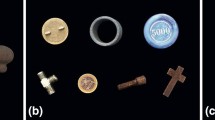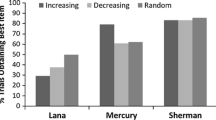Abstract
This research examined exchange and value attribution in tufted capuchin monkeys (Cebus apella). We presented subjects with opportunities to obtain various foods and a tool from an experimenter in exchange for the foods or tool in the subjects' possession. The times elapsed before the first chow biscuits were expelled and/or an exchange took place were recorded as the dependent measures. Laboratory chow biscuits, grapes, apples, and a metal bolt (a tool used to probe for syrup) were used as experimental stimuli. The subjects demonstrated the ability to recognize that exchanges could occur when an experimenter was present with a desirable food. Results indicate that subjects exhibited significant variation in their willingness to barter based upon the types of foods that were both in their possession and presented by the experimenter. Subjects more readily traded chow biscuits for fruit, and more readily traded apples for grapes than grapes for apples. During the exchange of tools and food, the subjects preferred the following in descending order when the probing apparatus was baited with sweet syrup: grapes, metal bolts, and chow biscuits. However when the apparatus was not baited, the values changed to the following in descending order: grapes, chow, and metal bolts. These results indicate that tufted capuchins recognize opportunities to exchange and engage in a simple barter system whereby low-valued foods are readily traded for more highly valued food. Furthermore, these capuchins demonstrate that their value for a tool changes depending upon its utility.



Similar content being viewed by others
References
Boinski S (1988) Use of a club by a white-faced capuchin (Cebus capucinus) to attack a venomous snake (Bothrops asper). Am J Primatol 14:177–179
Carpenter CR, Locke NM (1937) Notes on symbolic behavior in a Cebus monkey (Capucinus appella). J Gen Psychol 51:267–278
Chalmeau R, Peignot P (1998) Exchange of objects between humans and captive western lowland gorillas. Primates 39:389–398
Chapman A (1980) Barter as a universal mode of exchange. L'Homme 20(3):33–83
Costello MB, Fragaszy DM (1988) Prehension in Cebus and Saimiri 1. Grip type and hand preference. Am J Primatol 15:235–245
De Waal FBM, Luttrell LM, Canfield ME (1993) Preliminary data on voluntary food sharing in brown capuchin monkeys. Am J Primatol 29:73–78
Fernandes MEB (1991) Tool use and predation of oysters (Carssostrea rhizophorae) by the tufted capuchin, Cebus apella, in brackish water mangrove swamp. Primates 33:529–531
Fragaszy DM (1990) Early behavioral development in capuchins (Cebus). Folia Primatol 54:119–128
Hyatt CW, Hopkins WD (1998) Interspecies object exchange: bartering in apes? Behav Process 42:177–187
Magliocca F, Gautier-Hion A (1998) Social learning in primates: how to exchange tokens for food in mangabeys, Cercocebus torquatus torquatus (abstract). Folia Primatol 69:57–58
McGrew WC (1992) Chimpanzee material culture: implications for human evolution. Cambridge University Press, New York
Perry S, Rose L (1994) Begging and transfer of coati meat by white-faced capuchin monkeys, Cebus capucinus. Primates 35:409–415
Phillips KA (1998) Tool use in wild capuchin monkeys (Cebus albifrons trinitatis). Am J Primatol 46:259–261
Rose LM (1997) Vertebrate predation and food-sharing in Cebus and Pan. Int J Primatol 18:727–765
Westergaard GC (1998) What capuchin monkeys can tell us about the origins of Hominid material culture. J Mater Cult 31:5–19
Westergaard GC, Fragaszy DM (1987) The manufacture and use of tools by capuchin monkeys (Cebus apella). J Comp Psychol 101:159–168
Westergaard GC, Suomi SJ (1997) Transfer of tools and food between groups of tufted capuchins (Cebus apella). Am J Primatol 43:33–41
Westergaard GC, Liv C, Chavanne TJ, Suomi SJ (1998) Token-mediated tool-use by a tufted capuchin monkey (Cebus apella). Anim Cogn 1:101–106
Author information
Authors and Affiliations
Corresponding author
Rights and permissions
About this article
Cite this article
Westergaard, G.C., Liv, C., Rocca, A.M. et al. Tufted capuchins (Cebus apella) attribute value to foods and tools during voluntary exchanges with humans. Anim Cogn 7, 19–24 (2004). https://doi.org/10.1007/s10071-003-0181-z
Received:
Revised:
Accepted:
Published:
Issue Date:
DOI: https://doi.org/10.1007/s10071-003-0181-z




